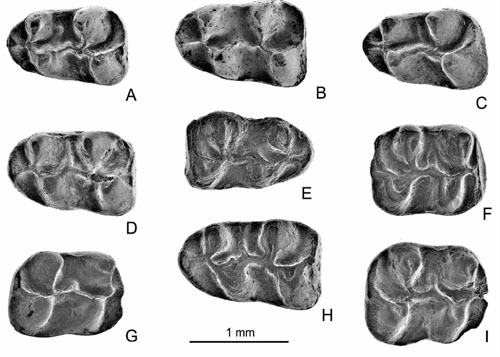| Location: Home > Research > Research Progress |
| Earliest Democricetodon (Cricetid Rodent) Found in the Early Miocene of the Junggar Basin, China |
|
According to a paper published in the latest issue of Vertebrata PalAsiatic 2011(4), palontologists from Institute of Vertebrate Paleontology and Paleoanthropology, Chinese Academy of Sciences, have identified two cricetid rodents (Democricetodon sui sp. nov. and Democricetodon? sp.) in the Early Miocene of the Junggar Basin, northern Xinjiang, China. The specimens come from two localities within the Suosuoquan Formation, which have been dated by magnetostratigraphy to between 21.9 and 21.16 Ma (Aquitanian), and turn out to be the oldest examples of Democricetodon known from central and eastern Asia. Comparisons with other Early Miocene cricetids and re-examination of the type species of Spanocricetodon indicate that D. sui is characteristic of the Xiejian age in Central Asia. The detailed comparisons confirm that the genus Spanocricetodon sensu lato Li (1977) is valid and clearly differs from Democricetodon and Primus, and show that some species that have previously been assigned to Spanocricetodon actually belong to other genera. Only one species of cricetid, Eucricetodon aff. E. caducus, is known from the Late Oligocene of the Junggar Basin. In the regional fossil record, this species does not survive beyond the Oligocene-Miocene boundary, and Democricetodon sui is the first cricetid to replace it in the Early Miocene. However, the clear differences between D. sui and Eucricetodon aff. E. caducus from the Late Oligocene of the same region indicate that D. sui is unlikely to have originated from the Paleogene cricetids in the region, but probably represents a species that immigrated to Central Asia. The similarity of D. sui to the two Anatolian and Greek species D. anatolicus and D. doukasi suggests that the three species are quite closely related, which would imply a rapid dispersion and diversification of the genus in Eurasia around the Oligocene-Miocene boundary. “The morphological similarities noticed between D. sui and the earliest Democricetodon species of Europe and Anatolia imply that this genus spread quickly across Eurasia soon after its appearance. The abundant samples collected in the Late Oligocene of the Junggar Basin indicate that the presence of Democricetodon in this region before the Miocene is unlikely. The morphology of D. sui is different in many respects from that of Eucricetodon aff. E. caducus from the Late Oligocene of the same basin. This difference indicates that D. sui is likely an immigrant species in Central Asia”, said Dr. Olivier Maridet, the lead author. All specimens are deposited in the collections of the Institute of Vertebrate Paleontology and Paleoanthropology, CAS. They are catalogued under the numbers IVPP V 17683.1-14 and V 17684.1-4. The original paper "Earliest occurrence of Democricetodon in China, in the Early Miocene of the Junggar Basin (Xinjiang), and comparison with the genusSpanocricetodon. Olivier MARIDET, WU Wen-Yu, YE Jie, BI Shun-Dong, NI Xi-Jun, MENG Jin. Vertebrata PalAsiatic 2011(4), 393-405" is available on http://www.ivpp.cas.cn/cbw/gjzdwxb/xbwzxz/201110/P020111031566064573166.pdf. This work is supported by the Chinese National Natural Science Foundation and a Research Fellowship for International Young Researchers from the Chinese Academy of Sciences. Fig.1 Upper cheek teeth of Democricetodon sui sp. nov. (A-F) and Democricetodon? sp.(G-H) from the Early Miocene of the Junggar Basin (Photos by Olivier Maridet)
Fig.2 Lower cheek teeth of Democricetodon sui sp. nov. (A-G) and Democricetodon? sp. (H-I) from the Early Miocene of the Junggar Basin (Photos by Olivier Maridet) |

